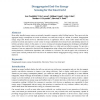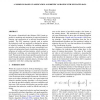PERVASIVE
2011
Springer
13 years 7 months ago
2011
Springer
Most utility installed energy meters are primarily intended to support a utility's billing function. They report only the aggregate energy consumption of a home or business o...
JMLR
2010
13 years 11 months ago
2010
L1 (also referred to as the 1-norm or Lasso) penalty based formulations have been shown to be effective in problem domains when noisy features are present. However, the L1 penalty...
AICS
2009
14 years 2 months ago
2009
Multi-class classification algorithms are very widely used, but we argue that they are not always ideal from a theoretical perspective, because they assume all classes are characte...
JVCIR
2006
14 years 4 months ago
2006
In this paper, we propose a framework to carry out supervised classification of images containing both textured and non textured areas. Our approach is based on active contours. U...
COMSIS
2006
14 years 4 months ago
2006
In this paper we present an improvement of the precision of classification algorithm results. Two various approaches are known: bagging and boosting. This paper describes a set of ...
ICML
2010
IEEE
14 years 5 months ago
2010
IEEE
We propose a novel approach that reduces cost-sensitive classification to one-sided regression. The approach stores the cost information in the regression labels and encodes the m...
ESANN
2006
14 years 5 months ago
2006
Currently the best algorithms for transcription factor binding site prediction are severely limited in accuracy. In previous work we combine random selection under-sampling with th...
WSC
2008
14 years 6 months ago
2008
We present a Generalized Lotka-Volterra (GLV) based approach for modeling and simulation of supervised inductive learning, and construction of an efficient classification algorith...
FLAIRS
2007
14 years 6 months ago
2007
Traditional supervised classification algorithms require a large number of labelled examples to perform accurately. Semi-supervised classification algorithms attempt to overcome t...
DEXA
2006
Springer
14 years 8 months ago
2006
Springer
We introduce a classification framework for continuous multivariate stream data. The proposed approach works in two steps. In the preprocessing step, it takes as input a sliding wi...



